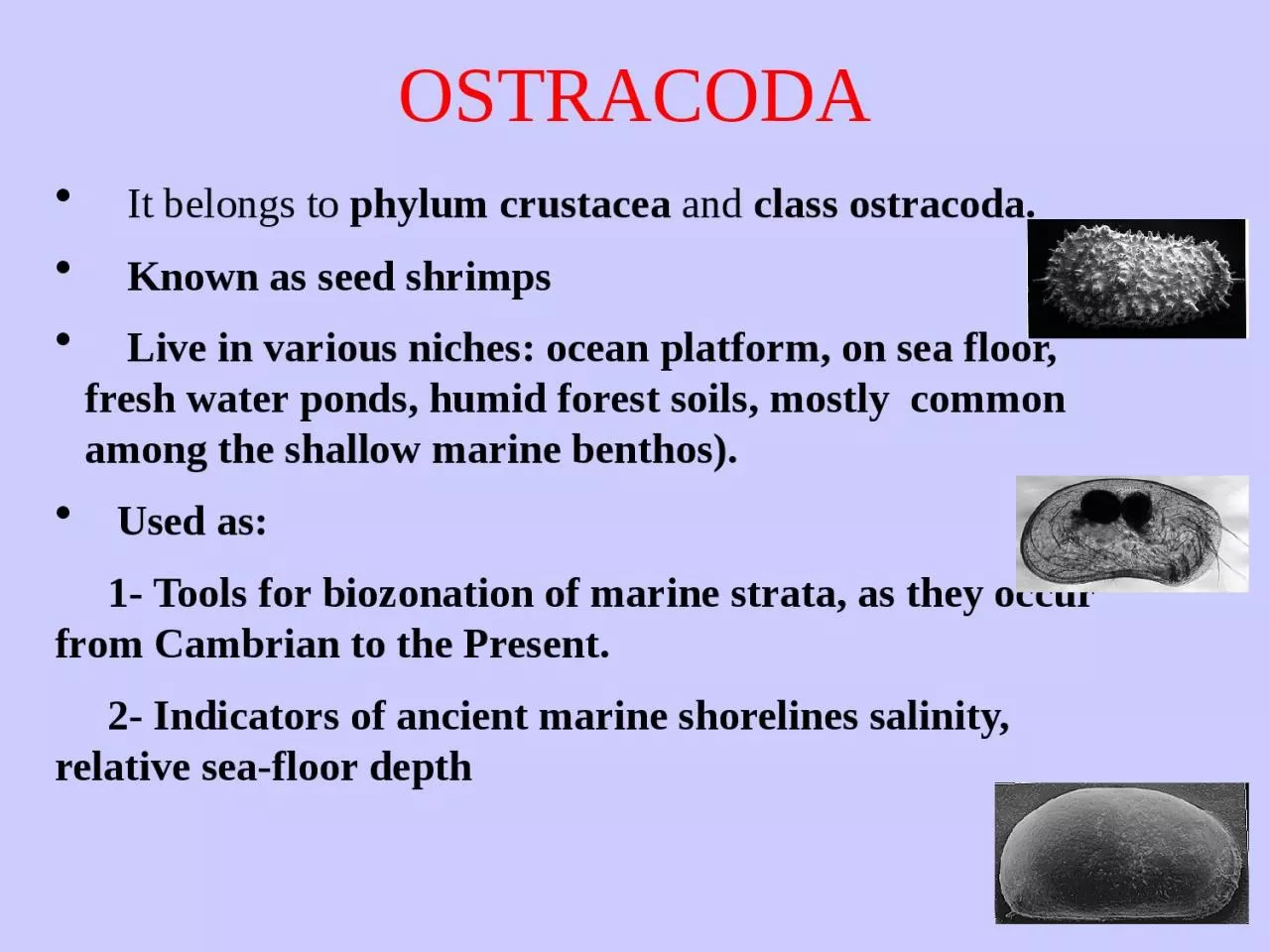

phylum crustacea and class ostracoda Known as seed shrimps Live in various niches ocean platform on sea floor fresh water ponds humid forest soils mostly common among the shallow marine benthos ID: 1033145
Download Presentation The PPT/PDF document "1 OSTRACODA It belongs to" is the property of its rightful owner. Permission is granted to download and print the materials on this web site for personal, non-commercial use only, and to display it on your personal computer provided you do not modify the materials and that you retain all copyright notices contained in the materials. By downloading content from our website, you accept the terms of this agreement.
1. 1OSTRACODA It belongs to phylum crustacea and class ostracoda. Known as seed shrimps Live in various niches: ocean platform, on sea floor, fresh water ponds, humid forest soils, mostly common among the shallow marine benthos). Used as: 1- Tools for biozonation of marine strata, as they occur from Cambrian to the Present. 2- Indicators of ancient marine shorelines salinity, relative sea-floor depth
2. 21) Neocythere denticulata 2) Neocythere vanveenae 3) Mandocythere harrisiana 4) Protocythere albae 5) Cornicytereis larivourensis 6) Cythereis reticulata 7) Cythereis folkestonensis 8) Isocythereis fortinodis 9) Platycythereis gaultina 10) Rehacythereis luermannae
3. 3Composition of carapace: Chitinous (rarely fossilized) and calcareous (fossilized).Size: range from 0.3-30 mm long (average size is typically about 1mm long).Shape: ovate, kidney, or bean-shaped.Carapace consists of two valves (right and left). These two valves are connected at the dorsum by a hinge and separate at the ventral.Valves of a shell are not commonly the same size, so one overlaps the other.MORPHOLOGY OF THE OSTRACOD CARAPACE
4. 4
5. 5
6. 6 TACTILE FEATURES (feeling by the surrounding environment): -- Setae (from pore canals and marginal pore canals) -- Eyes (near eye spot/eye tubercle, specially for shallow water forms, deep water forms are blind). Ornamentation: The outer surfaces of the ostracod valves can be smooth or ornamented with pits, striations, reticulations, spines, sulci, tubercles, wings-shaped (alae).
7. 7Common ornamentations in ostracods
8. 8ORIENTATION OF THE SHELL From side view: -Rounded end (the highest) )is anterior and pointed end is posterior. -Dorsal outline is convex (often straight), while the ventral outline is straight, concave or sometimes with less convexity. - eye-spot (if present) occur in an anterodorsal position. From dorsal/ventral view: - Broadest region occurs near the posterior From the interior: adductor muscle scars occur near the anterior end. Spines and alae (wings) are generally directed towards the posterior. Ornamentation is heavier at the posterior than is at the anterior.
9. 9
10. 10ONTOGENYOstracods grow by moulting. There are usually eight moults between the egg and the adult.What is the dimorphism? Dimorphic two shells are typically similar in everything but not in size. Male-shell is generally longer than the female-shell.
11. 11ARTICULATIONCan be done by the following:Ligament (chitinous material, unfossilized)Hinge (teeth, sockets, ridges and grooves) - Adont hinge - Merodont hinge - Entomodont hinge - Amphidont hinge3. Ridges on the duplicatureAdductor muscles (leave muscle scars inside and a subcentral tubercle/sulcus outside).